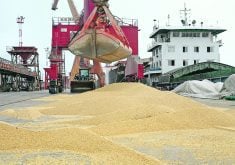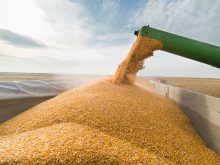Farmers watching the Canadian Wheat Board’s Fixed Price Contract
program, or FPC, noticed something odd and unsettling for a few days
after June 27.
Hard red spring wheat futures were roaring higher, but prices offered
to farmers by the FPC fell.
A big weather rally was occurring on the Minneapolis Grain Exchange,
but farmers weren’t being offered all the gains.
That changed as grain futures continued to surge, but by July 12,
futures had increased by $23.20 from June 27, while the FPC had only
Read Also

Trump’s tariffs take their toll on U.S. producers
U.S. farmers say Trump’s tariffs have been devastating for growers in that country.
risen $10.10.
To Alberta Agriculture market analyst Charlie Pearson, this kind of a
situation hurts the program’s credibility.
“It makes it a less desirable alternative than it might have been,”
said Pearson.
“I think that it’s important for farmers to be able to capture some of
these weather rallies.”
On June 25, Minneapolis hard red spring wheat futures were trading for
$178.33 per tonne and the fixed price contract was offering $203.05,
which was the result of the futures price plus that month’s FPC basis.
The wheat board’s Pool Return Outlook was forecasting final prices of
$202.
On June 27, the Minneapolis hard red spring wheat rally had begun,
taking December futures up to $186.23. But the FPC price dropped to
$197.85. That was because the basis had fallen from $24.72-over to
$11.62-over.
It took until July 2 to catch back up to the June 25 FPC price.
Laurence Klusa, the wheat board’s head of risk management, said the
late-June, early-July situation was created by the change in basis
levels, which are set once per month on the day the PRO is released.
The basis reflects the difference between the PRO and the futures price
on the day the PRO is released, but also includes deductions for the
time value of money, an administration charge and a risk premium.
Generally, the FPC price should be less than the PRO price by a few
dollars to reflect those three deductions.
But the basis can vary depending on the range between PRO and futures
prices because the board’s risk changes, Klusa said.
If market prices are below wheat board expectations, there is more risk
and a higher risk premium. If the market price is above board
expectations, the risk premium shrinks.
There can also be a change in the difference between the PRO price and
the futures price. A sudden price surge can have a big effect on the
FPC.
“We’ve had some pretty significant price moves,” said board risk
manager Richard Dzisiak. “It’s been pretty dramatic.”
The increasing futures price during June meant that by the end of the
last PRO period, the FPC price wasn’t discounted compared to the PRO
price, but was above it by $1.05 per tonne.
The FPC price at the start of that PRO period, on May 24, was $3.25
below the PRO price.
On June 27, the PRO and the FPC basis were reset, bringing the FPC
price back under the PRO by $3.15.
That means that between the two PROs the differential didn’t change
much, but swings in the futures market caused often significant day to
day swings.
If basis levels were reset every day, the price anomaly that occurred
in late June and early July wouldn’t have occurred. But Dzisiak said
the program is based on some fixed foundations.
“You need to keep a couple of things stable,” said Dzisiak.
Klusa said producers may want to pay more attention to basis levels if
they are thinking of using the board’s fixed price contracts.
“If the producer is just looking at the fixed price contract price, he
may not be looking that closely at the basis,” he said.
But the board’s basis contract program, which complements the fixed
price contract, allows farmers to lock in a basis before or after they
accept a futures price.
“If producers watch it closely enough, they’d be wise to sign up with
the larger basis,” said Klusa.
Pearson thinks the board should consider coming out with a new PRO if
the markets move dramatically, to avoid huge shifts in the FPC basis.
“If price levels or market conditions change fairly significantly in
between your typical fourth Thursdays, then you could come out with a
PRO in between,” he said.
Pearson has suggested farmers use the FPC program to get quick cash
flow after harvest, something that could be useful this year.
“The opportunity is there to maybe lock in a bit of a better price than
Pool Return Outlooks,” said Pearson.
“Even in a drought year, your cash flow is important, and it may be
that a farmer has to sell his whole crop off the combine just to pay
his bills.”















